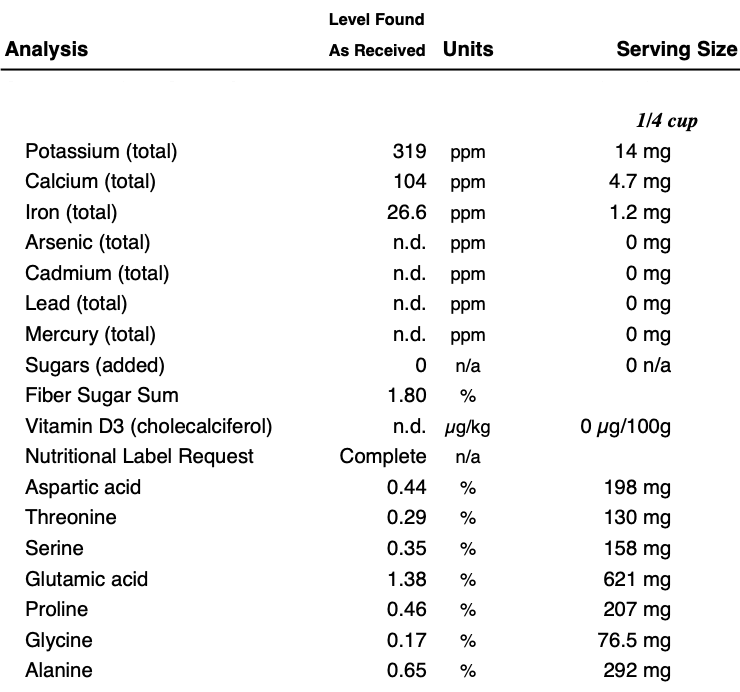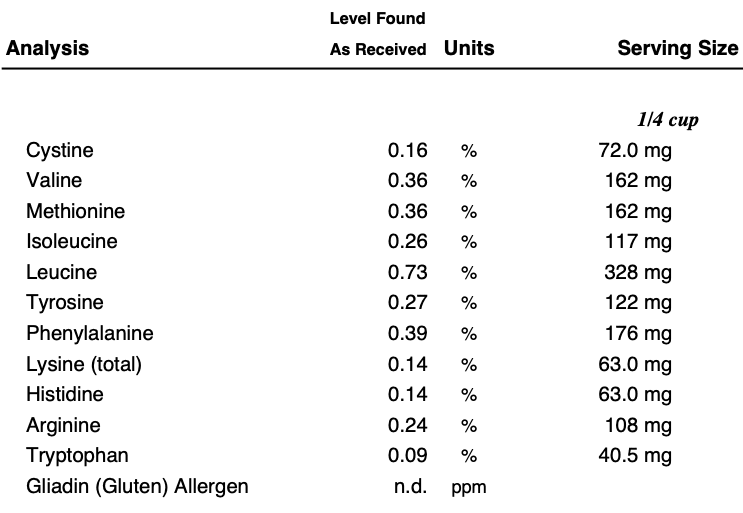
Fonio has been a staple food in West African societies for millennia, with traces of its cultivation dating as far back as 7,000 years across Mali, Senegal, Guinea, Nigeria, Chad and surrounding areas. Fonio’s resilience in difficult climates and resistance to drought make it a crucial crop in this part of the world, but studies have also found that this ancient super grain has much more to offer than just being a sustainable, affordable source of nutrition.
Often referred to as “hungry rice”, fonio is a primary source of protein for millions of financially destitute people in developing countries throughout Africa & Asia. However, fonio is now garnering international recognition as a potentially healthier alternative to other common cereals, pushing its reputation far beyond this unfavorable moniker. As we better understand the grain’s nutritional & chemical properties—paired with its sustainability as a crop—fonio presents the unique case as a food that may be necessary to fight hunger and nutritional deficiencies not just within its local communities, but around the globe as climates shift.
Types of Fonio
There are two species of fonio, however, the more common type that we will focus on in this article is white fonio (Digitaria exilis). White fonio, also known as “Acha” in Nigeria, is far more prevalent and the type that you will likely find in stores. The second variety, black fonio (Digitaria iburua), is not as widely farmed but can be found in parts of Nigeria, Togo and Benin. Black fonio is often referred to as Iburu.
Processing Fonio
Of the different processing methods used for fonio, the most common method preferred by both local consumers in West Africa and global consumers involves decortication and pregelatinization of the grain. Decorticating fonio involves removing the tough outer husk, revealing the edible grain within. Once decorticated, the fonio undergoes pre-cooking (parboiling) or pregelatinization. This method involves briefly steaming or toasting the grain, followed by grinding or flattening it. Pregelatinization alters the starch structure of the fonio, allowing it to absorb water more rapidly during cooking. The result is a remarkably fast-cooking grain, which is ready to serve in less than 5 minutes. This process also imparts a fluffiness to the cooked fonio, making it a versatile and time-efficient option for those seeking a nutritious and convenient meal.
Currently, all of the organic fonio we supply here at Terra Ingredients has undergone decortication and pregelatinization (a.k.a. “pearled fonio”), and the following nutritional analysis is based on this processing method.

Shown: Pearled white fonio grain (left) and fonio flour (right)
Fonio’s Nutritional Breakdown
Before we dive into fonio’s nutritional contents, it is important to note that research on fonio’s nutritional benefits is still relatively limited and that reported data often fluctuates based on a number of factors. These factors include where the fonio was grown, environmental conditions, processing, preparation, and testing methods. We have partnered with CAA, a local family-owned company, to build a processing facility in Dakar, Senegal and have conducted third-party studies of our organic fonio with two US-based laboratories, so we will rely on internal data regarding fonio’s nutritional composition in this analysis.
Below you can find our standard nutrition fact table for Terra Ingredients pearled fonio. These values are in accordance with the USDA recommended serving size of a quarter cup (45-50 grams) of dry fonio, or a half cup of cooked, pearled fonio.

For a detailed breakdown of pearled fonio’s micro and macronutrients, see the tables below from a study we conducted with Midwest Laboratories in 2018:

Pearled fonio micronutrients (chemicals and minerals):


Protein & Amino Acids
One of fonio’s best assets is that its proteins contain higher quantities of essential amino acids like methionine, cystine, valine, leucine and isoleucine that are generally missing in today’s major cereals. Proteins with more amino acids are considered superior because they offer a wider range of essential amino acids, which are crucial for various biological functions in the body such as tissue repair, muscle growth, and hormone synthesis. A diverse amino acid profile ensures a higher quality protein source, promoting optimal health and supporting the body’s overall nutritional needs. Organic fonio is particularly high in methionine, which is an antioxidant that may help protect the body from damage caused by ionizing radiation, detoxify harmful substances, and prevent liver damage.
Fonio typically contains similar protein levels to white & brown rice, with a ½ cup of cooked pearled fonio containing 3 grams of protein, which would equate to roughly 4% of the total DV for a sedentary 50-year-old woman who weighs 140 pounds. However, fonio’s amino acid profile means that a 1-1 comparison doesn’t tell the full story in terms of nutritional benefits since not all proteins are created equal.
Fiber
Pearled fonio contains 1 gram of fiber per serving, which is 2-3 times higher than that of white rice (USDA). Fiber is an essential component of a healthy diet, as it plays a crucial role in maintaining digestive health and preventing certain diseases such as heart disease, diabetes, and colon cancer. It also helps promote feelings of fullness and aids in weight management.
Consuming low-fiber carbohydrates on their own, such as white bread, white rice and common cereals, can lead to glucose spikes that can have a litany of short and long-term health effects. Conversely, fonio’s inherent fiber content assists with breaking down glucose once it enters the body, limiting spikes and potential negative side effects. When paired with high-fiber vegetables, fonio can serve as the foundation of numerous healthy cuisines.

Vitamins & Minerals
Despite its small size, fonio is a rich source of several important vitamins and minerals. For example, a ¼ cup serving of Terra Ingredients pearled organic fonio has shown to contain 1.2 milligrams of iron, which is roughly 9% of the recommended daily intake depending on age & gender. Iron is a crucial nutrient that plays a vital role in the production of red blood cells and the transportation of oxygen throughout the body.
Fonio is also an excellent source of thiamine (vitamin B1) and other B-complex vitamins, with a 50 gram serving providing 0.015 milligrams of this essential vitamin, which is about 12.5% of the recommended daily intake for adults. Thiamine is important for maintaining healthy nervous system function and performs a critical role in converting food into energy, with other B vitamins aiding in the production of new blood cells and the preservation of healthy skin cells, brain cells, and other bodily tissues.

Source: Medallion Labs, Minneapolis, MN, 2020
In addition to iron and thiamine, fonio is also a good source of zinc, magnesium, and phosphorus. These three micronutrients play roles in a wide variety of important bodily functions, including immune system function, wound healing, cell growth & division, muscle & nerve function, blood pressure regulation, bone health, energy metabolism and DNA synthesis.

Source: Medallion Labs, Minneapolis, MN, 2020
Phytochemical Compounds
Multiple studies, including a recent one from the Laboratory of Nutrition and Pharmacology (Jocelyn et al., 2020) also found that organic fonio cereal is rich in phytochemical compounds such as flavonoids and tannins, giving it therapeutic properties, especially anti-inflammatory, antibacterial, antioxidant, antithrombotic, heart protection, and vasodilatory. Phytic acid has been linked to the reduction of cholesterol, while phytate is associated with a lower risk of cancer.
Other Benefits of Fonio
Fonio has a reputation for being highly digestible, and has been conventionally prescribed for children, elderly individuals with poor tolerance to other grains, individuals who are unwell, and those afflicted with diabetes or gastric ailments. Research has shown that fonio carries a glycemic index of 66, which is lower than sorghum (72), white rice (70+) and millet (70), making it ideal for those who need to control blood sugar levels.
Gluten-Free
Fonio’s gluten-free status makes it an excellent alternative for individuals with gluten sensitivities or celiac disease, which can cause damage to the lining of the small intestine and result in malabsorption of nutrients. Fonio flour can also be used as a versatile ingredient in gluten-free baked goods, such as bread, cakes, and cookies. Its light, fluffy texture and mild flavor make it an excellent substitute for wheat flour in many recipes

Nutritious Without Sacrificing Flavor
The taste of fonio is often described as delicate, nutty, and slightly sweet, with hints of earthiness. Its unique flavor profile makes it a versatile ingredient that can be used in both sweet and savory dishes. In West African cuisine, fonio is traditionally used to make porridge, couscous, and various types of bread. However, in recent years it has gained popularity in Western countries as a healthier alternative to other grains like rice and quinoa—the latter being a pseudo-cereal as it is technically a seed.
Fonio’s mild yet distinctive flavor profile makes it an ideal ingredient for dishes like salads, stir-fries, and grain bowls, where its flavor can complement a variety of other ingredients. As the common African proverb says, “Fonio never embarrasses the cook”.
Conclusion
Fonio, both in its pearled and whole grain form, is a highly nutritious grain that will continue to be a staple food for millions of people in Africa and Asia, but its health benefits and sustainability make a strong case for it to be consumed on a global scale. When paired with other high-protein and fiber-rich foods, fonio can act as a well-rounded foundation to a healthy diet for most individuals. Our research and other evidence has been compelling enough that international food brands have already begun introducing fonio-based products into supermarkets in Europe, North America and beyond—and we see no signs of this slowing down. Processing and sustainability challenges still need to be resolved to ensure that local food chains are not compromised as demand grows, but the future of fonio consumption looks bright as more and more people discover its health benefits and versatility in cooking.
Jocelyne, R. E., Béhiblo, K., & Ernest, A. K. (2020). Comparative study of nutritional value of wheat, maize, sorghum, millet, and fonio: some cereals commonly consumed in Côte d’Ivoire. European Scientific Journal ESJ, 16(21), 118-131.





